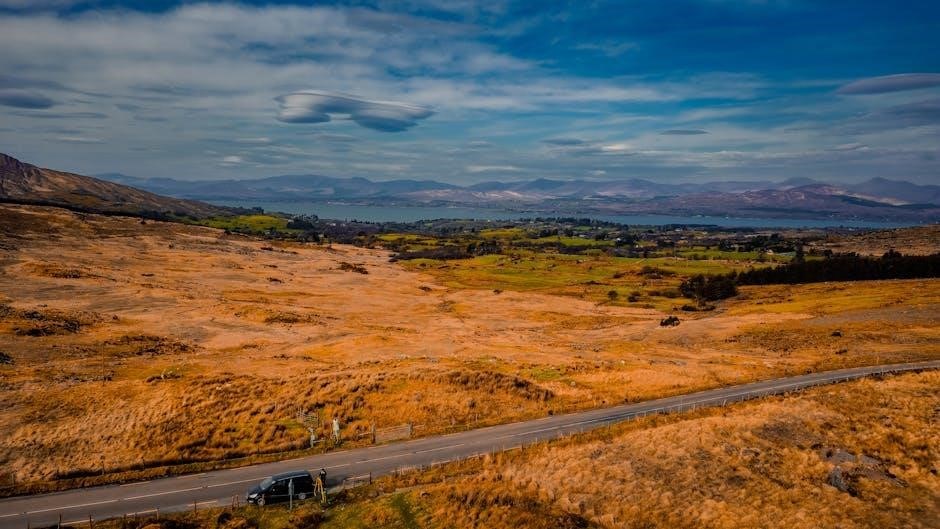This document explores the genealogy of the Anderson family, focusing on William Anderson, born in 1736 in Ireland, tracing their Scottish roots, migration, and cultural impact.
Overview of the Document’s Purpose and Scope
The Ireland William Anderson Family PDF serves as a comprehensive genealogical resource, tracing the lineage and history of the Anderson family, with a focus on William Anderson, born in 1736 in Ireland. The document outlines the family’s Scottish origins, their migration to Ireland during the Plantation of Ulster, and their cultural and economic contributions to the region. It also explores historical events, such as the burning of David Anderson’s house, and tensions between Scottish settlers and native Irish. The PDF provides detailed insights into estate records, DNA connections, and census data, offering a roadmap for genealogical research and understanding the Anderson family’s legacy in Ireland and beyond.
Significance of the Anderson Family in Irish and Scottish History
The Anderson family holds a profound place in both Irish and Scottish history, tracing their origins to Scotland before migrating to Ireland during the Plantation of Ulster. As Scottish settlers, they brought cultural and economic contributions that shaped Ulster’s identity. The Anderson surname, meaning “son of Andrew,” reflects their Scottish heritage and patronymic traditions. Their presence in Ireland influenced local demographics and societal structures, while their resilience amid tensions with native Irish populations underscores their adaptability. Notable figures like William Anderson, a Victoria Cross recipient, and John Anderson, a genealogist, further highlight the family’s enduring legacy in both nations’ histories.

Origins of the Anderson Family
The Anderson family traces Scottish roots, with the surname meaning “son of Andrew.” They migrated to Ireland during the Plantation of Ulster, settling in Ulster.
Scottish Roots and the Meaning of the Anderson Surname
The Anderson surname, meaning “son of Andrew,” originates from Scotland, where it first appeared in the 14th century as “Fitz Andreu.” Over time, it evolved into “Anderson,” becoming a common Scottish name. The name Andrew, derived from the Greek “Andreas,” symbolizes strength and masculinity. Scottish Andersons were part of the broader Gaelic culture, with their surname reflecting a patronymic tradition. During the Plantation of Ulster in the 17th century, many Andersons migrated to Ireland, settling primarily in Ulster. This migration marked the beginning of the Anderson family’s significant presence in Ireland, blending Scottish heritage with Irish identity. Their roots in Scotland remain a cornerstone of their historical legacy.
Migration to Ireland During the Plantation of Ulster
The Anderson family’s migration to Ireland occurred during the Plantation of Ulster in the 17th century, a period of significant Scottish settlement. Driven by economic opportunities and political incentives, Scottish families, including the Andersons, relocated to Ulster. This migration reshaped the region’s cultural and demographic landscape, blending Scottish traditions with Irish identity. The Andersons, like many settlers, brought Presbyterian faith and customs, contributing to Ulster’s unique character. While tensions arose with native Irish, the Andersons adapted and thrived, establishing roots that would endure for generations. This period marked a pivotal chapter in the Anderson family’s history, shaping their legacy in Ireland.

Cultural and Economic Contributions of Scottish Settlers in Ulster
Scottish settlers, including the Andersons, brought significant cultural and economic contributions to Ulster during the Plantation period. They introduced Presbyterianism, shaping the region’s religious identity, and established thriving agricultural communities. Their expertise in farming and trade boosted Ulster’s economy, fostering growth in linen production and commerce. The settlers’ customs, language, and traditions blended with Irish culture, creating a unique identity. Despite initial tensions with native Irish, the Andersons and other Scottish families adapted, contributing to Ulster’s prosperity. Their resilience and entrepreneurial spirit laid the foundation for the region’s development, leaving a lasting legacy in Ireland’s history and cultural landscape.

Genealogy of William Anderson
William Anderson, born in 1706 to Scottish parents, married Rebecca Denny, migrated from Ireland in 1742, and died tragically in 1783, impacting his family’s legacy.
William Anderson: Early Life and Ancestry
William Anderson, born in 1706 to Scottish parents, hailed from a family deeply rooted in Scottish heritage. His early life in Ireland was marked by strong Presbyterian traditions. He married Rebecca Denny, and their union laid the foundation for a prominent family lineage. William’s ancestry traces back to Scotland, reflecting the broader migration of Anderson families to Ireland during the Plantation of Ulster. His father, a farmer, instilled values that shaped William’s character. This period set the stage for his eventual migration to America, driven by ambition and adversity, forever linking his name to both Irish and American history.
Marriage and Family: Rebecca Denny and Their Children
William Anderson married Rebecca Denny, a member of a respected Scottish-Irish family, around 1730. Their union produced six children, with John and David born in Ireland before the family’s migration to America. Four additional children were born after their settlement in Pennsylvania. Rebecca played a pivotal role in maintaining family stability amid relocation and hardship. Her background and character likely influenced the family’s resilience. The marriage and subsequent children underscored William’s commitment to building a legacy, blending Scottish and Irish traditions. Their family life was marked by both opportunity and tragedy, shaping the Andersons’ enduring impact on their descendants.

Migration from Ireland to America: Timeline and Reasons
William Anderson and his family migrated from Ireland to America around 1742, settling initially in Chester County, Pennsylvania. Driven by economic opportunities and religious freedom, they later moved to South Carolina. This migration reflected broader Scottish-Irish emigration trends, seeking better prospects amid Ireland’s political instability. The journey marked a pivotal shift in the family’s history, establishing roots in America while maintaining their Scottish and Irish heritage.
Tragic Death and Its Impact on the Family
William Anderson’s tragic death in 1783, reportedly at the hands of a group, sent shockwaves through his family. His murder occurred the same night his son David’s house was burned, destroying vital family records. This devastating event forced the family into temporary shelter under a wagon shed, where Tyger Jim Anderson was later born. The loss of William and the destruction of records disrupted the family’s stability and genealogical continuity. His death marked a turning point, testing the family’s resilience and adaptation abilities. This tragedy remains a poignant chapter in the Anderson family’s history, illustrating their strength amidst adversity and loss.
Descendants of William Anderson
William Anderson’s descendants, including John, David, and other children, grew into prominent figures, shaping the family’s legacy and expanding its influence across generations in Ireland and beyond.
John Anderson: Life and Legacy
John Anderson, a son of William Anderson, played a pivotal role in the family’s history. Born in Ireland, he later migrated to America, settling in areas such as Pennsylvania and South Carolina. John’s life reflects the resilience and adaptability of the Andersons, as he navigated challenges and opportunities in the New World. His contributions to the family legacy include maintaining strong ties to their Scottish and Irish heritage while carving out a new life across the Atlantic. John’s story is a testament to the enduring spirit of the Anderson family, bridging their origins and future generations.
David Anderson: Role in the Family’s History
David Anderson, a son of William Anderson, was born in Ireland and later migrated to America with his family. His life was marked by resilience, as his house was burned in 1783, destroying vital family records. This event, occurring the night his father was murdered, forced the family to seek temporary shelter. David’s birth under a wagon shed symbolizes the family’s adaptability during hardships. His role in the Anderson family’s history underscores their ability to endure and rebuild, leaving a lasting legacy for future generations. David’s story is a testament to the strength and perseverance of the Andersons in the face of adversity.
Other Children and Their Contributions to the Family Tree
Beyond John and David, William Anderson and Rebecca Denny had four additional children born in America, expanding the family’s legacy. These siblings played crucial roles in shaping the Anderson family’s history, with their lives reflecting resilience and adaptability. Tyger Jim Anderson, born under a wagon shed after the family’s house was burned, exemplifies the hardships and resourcefulness of the Andersons. Each child contributed to the family’s growth, with some becoming key figures in preserving the family’s heritage. Their stories, intertwined with the broader migration from Ireland to America, highlight the enduring impact of the Anderson family’s journey and settlement in the New World.
Key Historical Events and Their Impact
The burning of David Anderson’s house in 1783 destroyed vital family records, while tensions with native Irish and Scottish settlers shaped the Andersons’ resilience and legacy in Ireland.

The Burning of David Anderson’s House and Its Consequences
The burning of David Anderson’s house in 1783 was a pivotal event in the Anderson family’s history. This incident occurred the night William Anderson was tragically murdered, resulting in the destruction of all family records. The loss of these documents has posed significant challenges for genealogical research, as vital information about the family’s lineage and history was lost. Following the fire, the family was forced to establish temporary living quarters under an improvised wagon shed. This period of hardship marked a turning point for the Andersons, as they sought to rebuild their lives amidst tragedy and loss. The event underscores the resilience and adaptability of the family in the face of adversity, shaping their legacy in Ireland and beyond.
Tensions Between Scottish Settlers and Native Irish
Tensions between Scottish settlers and the native Irish were a recurring theme during the Plantation of Ulster. The influx of Scottish settlers, including the Anderson family, brought cultural and religious differences that often led to conflict. The Presbyterian faith of the Scots clashed with the Catholic traditions of the Irish, creating social and political friction. Additionally, competition for land and resources exacerbated these tensions. Despite these challenges, the Andersons and other Scottish settlers played a significant role in shaping Ulster’s economy and society; Their resilience and adaptability allowed them to thrive, even amid the complex and often contentious relationship with the native Irish population.
Family Resilience and Adaptation in Ireland
The Anderson family demonstrated remarkable resilience and adaptability during their time in Ireland. Following the Plantation of Ulster, they navigated cultural and religious challenges while integrating into Irish society. Despite tensions with native Irish populations, the family thrived, contributing to the region’s economy through farming and trade. Their ability to adapt to new environments and maintain their Scottish heritage was key to their survival. The Andersons also faced personal hardships, such as the tragic death of William Anderson and the burning of David Anderson’s house. Yet, they persevered, rebuilding their lives and continuing to play a significant role in the community. Their resilience laid the foundation for future generations, both in Ireland and beyond.

Resources for Genealogical Research
Estate records, DNA connections, census data, and historical documents provide valuable insights into the Anderson family’s history, aiding researchers in tracing their lineage and heritage.

Estate Records and Land Ownership in Ireland
Estate records provide crucial insights into the Anderson family’s land ownership and economic status in Ireland. These documents, including lease agreements and rent rolls, detail tenant and landlord relationships. Many Andersons were tenants on large estates, while some held land themselves. The records reveal geographic locations and financial standings, aiding genealogical research. Historical land transactions and property management practices are also documented, offering a glimpse into the family’s daily life and societal role. These records are essential for tracing the Anderson family’s roots and understanding their place within Ireland’s social and economic landscape during the 18th and 19th centuries.
DNA Connections and Modern Genealogical Tools
DNA analysis has revolutionized genealogical research for the Anderson family, offering insights into ancestral connections. Platforms like AncestryDNA and 23andMe enable users to compare DNA results, identifying distant relatives and confirming family ties; This modern tool is particularly valuable for families with common surnames like Anderson, helping to distinguish between different lineages. By combining DNA evidence with traditional records, researchers can build more accurate family trees. While DNA provides a scientific link, it is often used alongside historical documents, church records, and census data to validate connections. This integrated approach enhances the understanding of the Anderson family’s heritage and migration patterns, making genealogy more accessible and precise for future generations.
Census Data and Historical Documents
Census data and historical documents are crucial for tracing the Anderson family’s history in Ireland. Records from 1901 and 1911 provide insights into family residences, occupations, and migration patterns. Estate records reveal land ownership and social status, while historical documents like wills and church records offer details on births, marriages, and deaths. These sources help reconstruct the Anderson family tree, linking individuals across generations. For instance, William Anderson’s emigration from Ireland to America is documented in passenger lists and naturalization records. Census data also highlights the family’s economic contributions, such as farming and trade. These documents are essential for verifying lineage and understanding the Andersons’ role in Irish society.
The Anderson Family Crest and Coat of Arms
The Anderson family crest and coat of arms symbolize the family’s Scottish heritage and historical roots. The crest typically features elements like a lion or cross, reflecting strength and faith. These heraldic symbols were used to identify the family and its legacy. While not all Anderson families have an officially registered coat of arms, those that do often trace their lineage to Scotland. The crest and coat of arms serve as a visual representation of the family’s history and values, connecting modern descendants to their ancestors’ achievements and traditions. They remain a cherished part of the Anderson family’s identity and heritage.
Notable Figures in the Anderson Family

The Anderson family boasts several distinguished individuals, including William Anderson, a central figure in Irish genealogy, John Anderson, noted for genealogical scholarship, and a Victoria Cross recipient.
James Anderson: Brother of William and His Descendants
James Anderson, born in 1730, was a significant figure in the Anderson family, being the brother of William Anderson. He married Sarah Young, and their union produced four children: William, Samuel, Sarah, and Jane. James’s life and descendants are crucial for understanding the broader Anderson family history. His children expanded the family tree, with each playing a role in shaping the family’s legacy. Researching James’s life, including his occupation and land records, offers valuable insights into the Andersons’ status and experiences in 18th-century Ireland. His descendants continued to contribute to the family’s history, making him a key ancestor for genealogical research.
John Anderson: Contributions to Genealogical Scholarship
John Anderson, a prominent figure in genealogical scholarship, was born near Glasgow in 1789. He made significant contributions to the field through his meticulous research and publications. His most notable work, The Scottish Nation, published in 1863, is a three-volume set detailing Scottish surnames, their origins, and histories. This work remains a cornerstone for tracing Scottish and Irish lineage. Anderson’s research provided invaluable insights into the Anderson family’s roots, bridging gaps between Scottish and Irish genealogical records. His scholarship has aided countless researchers in understanding their heritage, making him a pivotal figure in the study of the Anderson family’s history.
William Anderson: Recipient of the Victoria Cross
William Anderson, a Scottish soldier, earned the Victoria Cross for his valiant actions during World War I. Born in 1884, Anderson demonstrated exceptional bravery on March 12, 1915, while serving in France. Despite heavy enemy fire, he risked his life to rescue wounded comrades, showcasing remarkable courage. His selfless act of valor was recognized posthumously, as Anderson tragically lost his life in the same conflict. The Victoria Cross, Britain’s highest military honor, underscores his heroic legacy, making him an inspiration and a notable figure in the Anderson family’s history of service and sacrifice.
The Anderson family’s legacy in Ireland and beyond is marked by resilience, cultural contributions, and enduring historical significance, shaping a profound impact across generations and geography.
Legacy of the Anderson Family in Ireland and Beyond

The Anderson family’s enduring legacy is rooted in their resilience and cultural contributions. From their Scottish roots to their settlement in Ireland, they shaped Ulster’s economy and society. Their migration to America further expanded their influence, with descendants playing pivotal roles in various fields. Notable figures like William Anderson, a Victoria Cross recipient, and John Anderson, a genealogist, highlight the family’s diverse contributions. Historical events, such as the burning of David Anderson’s house, underscore their perseverance. This legacy serves as a testament to their adaptability and strength, leaving a lasting impact on both Ireland and the broader world.
Future Research Opportunities and Directions
Future research on the Anderson family could explore unexamined historical documents and DNA connections to uncover deeper genealogical links. Investigating estate records and land ownership in Ireland offers insights into their economic roles. Collaborative efforts with genealogical societies and historians could shed light on overlooked branches of the family tree. Additionally, studying the Andersons’ migration patterns and their impact on communities in America could reveal new historical perspectives. Exploring the family crest and coat of arms may also provide heraldic insights. These avenues promise to enrich the understanding of the Anderson family’s history and their enduring legacy across generations.